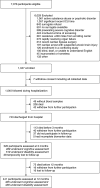Inflammation and Coagulation during Critical Illness and Long-Term Cognitive Impairment and Disability
- PMID: 33030981
- PMCID: PMC7958515
- DOI: 10.1164/rccm.201912-2449OC
Inflammation and Coagulation during Critical Illness and Long-Term Cognitive Impairment and Disability
Abstract
Rationale: The biological mechanisms of long-term cognitive impairment and disability after critical illness are unclear.Objectives: To test the hypothesis that markers of acute inflammation and coagulation are associated with subsequent long-term cognitive impairment and disability.Methods: We obtained plasma samples from adults with respiratory failure or shock on Study Days 1, 3, and 5 and measured concentrations of CRP (C-reactive protein), IFN-γ, IL-1β, IL-6, IL-8, IL-10, IL-12, MMP-9 (matrix metalloproteinase-9), TNF-α (tumor necrosis factor-α), soluble TNF receptor 1, and protein C. At 3 and 12 months after discharge, we assessed global cognition, executive function, and activities of daily living. We analyzed associations between markers and outcomes using multivariable regression, adjusting for age, sex, education, comorbidities, baseline cognition, doses of sedatives and opioids, stroke risk (in cognitive models), and baseline disability scores (in disability models).Measurements and Main Results: We included 548 participants who were a median (interquartile range) of 62 (53-72) years old, 88% of whom were mechanically ventilated, and who had an enrollment Sequential Organ Failure Assessment score of 9 (7-11). After adjusting for covariates, no markers were associated with long-term cognitive function. Two markers, CRP and MMP-9, were associated with greater disability in basic and instrumental activities of daily living at 3 and 12 months. No other markers were consistently associated with disability outcomes.Conclusions: Markers of systemic inflammation and coagulation measured early during critical illness are not associated with long-term cognitive outcomes and demonstrate inconsistent associations with disability outcomes. Future studies that pair longitudinal measurement of inflammation and related pathways throughout the course of critical illness and during recovery with long-term outcomes are needed.
Keywords: coagulation; critical illness; dementia; disability; inflammation.
Figures



Comment in
-
Biological Mechanisms of Cognitive and Physical Impairments after Critical Care. Rethinking the Inflammatory Model?Am J Respir Crit Care Med. 2021 Mar 15;203(6):665-667. doi: 10.1164/rccm.202010-3896ED. Am J Respir Crit Care Med. 2021. PMID: 33142075 Free PMC article. No abstract available.
-
No Strong Evidence for Ruling Out the Role of Coagulation in Long-Term Disability after Critical Illness.Am J Respir Crit Care Med. 2021 Sep 1;204(5):613. doi: 10.1164/rccm.202104-0980LE. Am J Respir Crit Care Med. 2021. PMID: 34111375 Free PMC article. No abstract available.
-
Reply to Yasuma et al.Am J Respir Crit Care Med. 2021 Sep 1;204(5):613-614. doi: 10.1164/rccm.202105-1133LE. Am J Respir Crit Care Med. 2021. PMID: 34111381 Free PMC article. No abstract available.
References
-
- Hopkins RO, Weaver LK, Collingridge D, Parkinson RB, Chan KJ, Orme JF., Jr Two-year cognitive, emotional, and quality-of-life outcomes in acute respiratory distress syndrome. Am J Respir Crit Care Med. 2005;171:340–347. - PubMed
Publication types
MeSH terms
Substances
Grants and funding
LinkOut - more resources
Full Text Sources
Other Literature Sources
Medical
Research Materials
Miscellaneous

